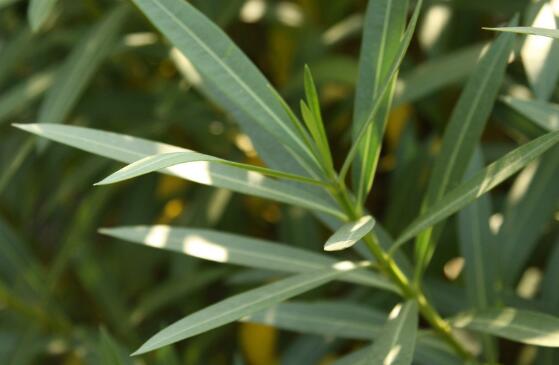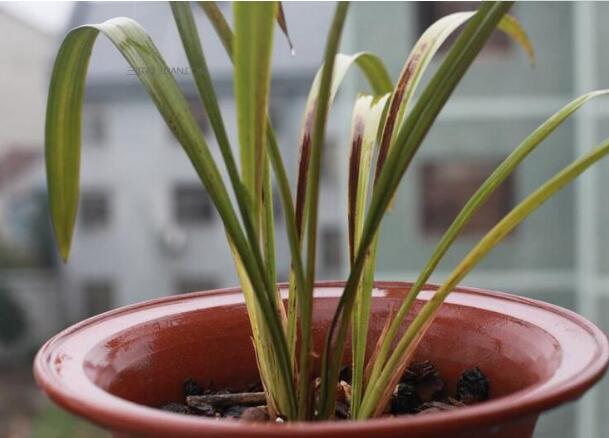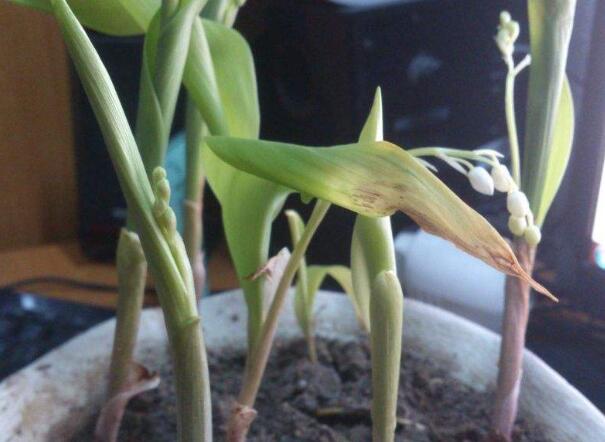How do oleander leaves turn yellow? learn 6 tricks to solve easily / water too much and light too little.
For oleander, we must have heard that although it is poisonous all over the body, its green leaves and large and beautiful flowers are very ornamental, so many people take risks to keep it. However, in the process of breeding, due to improper maintenance and other reasons, there will be symptoms of yellow leaves, then oleander leaves yellow how to do? The editor summarized several causes and solutions for the yellowing of oleander leaves. Go in and have a look.
First, how do oleander leaves turn yellow? find the cause.

About this problem, in fact, it is also simple to say, we just need to find the cause, and then solve it. There are only a few things that can cause oleander leaves to turn yellow, such as too much or too little watering, insufficient light, too much or too little fertilization, and so on. Next, the editor will tell you in detail.
Second, the causes and solutions of oleander leaves yellowing.
1. Environmental mutation
When it comes to the yellowing of oleander leaves, there are actually many reasons, but the first thing we think of is the environment. Because if your oleander is bought online, it may not adapt to a big change in the growth environment, and the leaves will turn yellow after a period of time.
Solution: for example, the store asks about the growing environment of oleander, and it remains the same after buying it back. Even if you want to change the environment, you have to gradually let it have an adaptation process. If the leaves are yellow caused by the environment, flower friends can put the oleander in a ventilated place and wait until the plant returns to normal before taking care of it in the normal way.
2. Lack of light
In the culture method of oleander, it has been introduced that oleander likes light, and it doesn't matter if it is illuminated by strong light, and its leaves will not turn yellow. But once the light is insufficient, the oleander branches will grow, and the leaves will turn yellow and fall off, thus seriously affecting its ornamental ability.
Solution: understand the growth habits of oleander and give it sufficient light. The best way is to put it in a place with plenty of light, such as balcony or windowsill and other places of careful maintenance, I believe that after a long time, the plant will return to health.
3. Overwatering
Oleander likes the wet environment, but it is not good to water too much, because it will cause stagnant water in the basin and lack of oxygen in the soil, resulting in root rot symptoms. After the appearance of rotten roots, the top leaves of oleander will be light yellow and wilted, and the old leaves will be dark yellow.
Solution: stop watering immediately, preferably loosen the soil and let the water evaporate. In addition, under the premise of not harming the roots, we should also dig up part of the soil and fill it with dry nutrient soil.
4. Lack
Oleander likes water, although too much water is not good, but too little is even more bad. Once unwatered for a long time, the lower branches and leaves of oleander will age and gradually become dry yellow, while the new leaves are normal.
Solution: in order to prevent water loss, immediately put oleander in a semi-shaded place, and pour some water, not more than one time. At the same time, the strong gap in the basin wall is loosened to drain water from the gap.
5. Excessive fertilization
Oleander has strong adaptability and low requirement for fertilizer. if it wants to look good, proper fertilization is very important. However, once too much fertilizer is applied, it will lead to the thickening and gloss of the new leaves, but the old man will gradually turn yellow and fall off.
Solution: if the amount of fertilizer is too large and too thick, resulting in oleander leaves yellowing, we should timely pour the pot to change the soil, and then remove all the leaves and replant. After appropriate watering, put oleander in a semi-shady place to maintain, wait for the germination of new leaves, and then transfer to normal cultivation.
6. Lack of fertilizer
Too much fertilization will lead to the yellowing of oleander leaves, but not too little fertilization, which will lead to lack of nutrients, resulting in thin branches, thin leaves and yellow tender leaves.
Solution: should be timely fertilization, increase nutrients, if there are conditions, we can also pour liquid rotten fertilizer and water to promote its growth ability.
Generally speaking, oleander is easy to raise, but because it is poisonous, many people will behave improperly in the process of breeding. But now that we have raised it, we should raise it well. besides, as long as we do not come into contact with oleander for a long time, it will not do harm to people. With regard to the yellowing of oleander leaves, the editor has introduced this, hoping to give you some help.
How to water oleander, if it is not dry or irrigated, it should be watered thoroughly / reduce the amount of water in winter
As a highly ornamental plant, oleander is highly poisonous, but its flowers and leaves are very beautiful, so many people keep it at home. Oleander has strong adaptability and does not require water and fertilizer, but if you want it to look better, watering is very critical. How to water oleander? Next, the editor will introduce the watering method of oleander.
First, how to water oleander, do not dry do not water
In the culture method of oleander, we have said that oleander likes a humid environment, so watering is very important. However, watering should not be excessive, because it will cause oleander leaves to turn yellow, so it is important to master the correct watering method. As for how to water oleander, we only need to master the eight-character principle: do not dry, do not water, water thoroughly.
1. No work, no watering
Oleander is a neutral plant, either dry or unwatered, which means wait for oleander to dry before watering. As for how to judge whether oleander should be watered or not, the editor has prepared two methods for everyone: one is to watch, and the other is to play:
① look at the basin soil with your eyes. If the soil turns white and cracks appear on the edge of the basin soil, this is a sign that the basin soil is dry, and people need to water it at this time. If the basin soil is dark brown and has no cracks, it means that the basin soil is still very wet and does not need watering.
② knock: pick up the flowerpot, bounce with your fingers and hit the basin wall. The sound is clear, indicating that the basin soil is dry and we are going to water it. If the sound sounds muddy after beating, it means that the soil is still wet and does not need watering.
2. if you pour it, you will pour it thoroughly.
How to water oleander, in addition to not dry do not water, we also need to master the principle of watering thoroughly. It means that when watering oleander, you can't stop watering oleander once and for all. Note: oleander is a wet plant. We would rather make it wet than dry.
It is reasonable to master the eight-character principle of how to water oleander, but when we look up the Internet, we will find that very few people can do this, and most of them can only achieve the degree that they will not dry to death or drown. So in order to better cultivate oleander, we go on to look at the watering method of oleander in the four seasons.
2. How to water oleander in winter / watering method in four seasons
When winter comes, the temperature drops sharply and the evaporation of water slows down. Therefore, to water oleander at this time, the amount of water should be reduced. Even if you want to water, you should also pay attention to the time, and it is best to choose it at noon, because the temperature at other times is too low, which will cause oleander to enter a dormant state.
Spring and autumn: in both seasons, the temperature is relatively suitable, and this is the best time for the growth of oleander peaches, so we should pour more water. Watering time: in the morning or afternoon.
Summer: in summer, the temperature rises to very high, when the water evaporates very quickly, in order to keep the basin soil moist, we should water oleander more. However, if the temperature is too high, oleander will enter a dormant period, at this time should be less watering. Watering time: morning will be evening, these two times the temperature is not high.
What about the yellowing of desert rose leaves? find out the cause of desert rose leaves yellowing.
Desert rose is named desert rose because its origin is close to desert, so its plant shape is similar to that of desert rose. Desert rose is a very popular breeding plant. The leaves of desert rose are often yellowed in the process of artificial breeding, so what about the yellowing of desert rose leaves?
Brief introduction of Desert Rose:
Desert rose (Latin name: Adenium obesum.), in fact, it is not a rose growing in desert areas, and it has no close relationship or resemblance to roses. Also known as Tian Baohua, Apocynaceae, which is a plant of Apocynaceae. Tianbao flower is a succulent plant, also known as succulent plant. Succulent shrubs or small trees, up to 4.5 m; trunk swollen. Leaves alternate, apical, Obovate to elliptic, 15cm long, entire, apex obtuse and mucronate, fleshy, subsessile. Like high temperature, dry and sunny environment, heat-resistant, not cold-resistant, named desert rose because its origin is close to desert and as red as rose; Kenya and Tanzania, which originated in Africa, are beautiful when they are in full bloom and are often cultivated and ornamental.
What if the desert rose leaves turn yellow:
One: have not yet adapted to the environment
Newly bought desert roses are in the adaptation period, and the phenomenon of a small amount of yellow leaves is very common, and it is normal to wait for it to adapt itself after a period of time.
Second: root rot
Plant roots need to breathe, keep the soil loose, the flowerpot is airtight, it is easy to cause root rot, once the root rot plants naturally can not absorb enough nutrients. The solution is to remove the rotten part and loosen the soil. If all the roots rot, it will be hopeless.
Three: too much watering
From the name of the desert rose, we can see that it is more drought-resistant and should not be watered too much each time, otherwise it is easy to cause rotten roots and yellowing leaves. Control watering after removing rotten roots.
Four: the temperature is too low
Desert roses will be dormant when the temperature is low in winter. the leaves turn yellow, dry and even lose leaves in order to reduce water evaporation and nutrient consumption. it is a mechanism of self-protection, so don't worry. If you want desert roses to come alive in winter, move into the greenhouse.
Five: lack of light
Desert rose is a sunny plant, sufficient light can ensure its normal growth. If you put it in the shade now, let it bask in the sun.
Six: poor ventilation
Poor ventilation will inevitably lead to yellow leaves of the plant, and in serious cases, the whole plant will rot and die. The solution is to take it to a "breeze", that is, to move to a well-ventilated location, such as balconies, windows, and so on.
Seven: excessive fertilization
On the one hand, excessive fertilization will make the soil impervious, on the other hand, the concentration of extracellular solution is too high, and the root cells lose water and die. The result is root rot until death. Therefore, fertilizers should be in the right amount, and remember not to apply too much.
Eight: insect pests
The main pest of desert rose is shell insect, which causes all leaves to fall off, plant growth point necrosis and even plant death when it occurs seriously. As soon as it is found that it is immediately wiped with water with cotton swabs, it can also be sprayed twice with 40% omethoate EC 1000 times or 50% fenitrothion EC 1000 times during spawning and incubation period.
Nine: diseases
Desert rose is mainly caused by leaf spot and root rot. When the leaf spot is serious, it can cause a large number of leaves to fall off. It can be controlled with 25% carbendazim wettable powder and 50% topiramate 1000 times. Root rot often causes root rot and death, which can be irrigated with 50% topiramine wet powder or 1000 times agricultural streptomycin.
Finally, it is necessary to pay special attention to: whether it is in the adaptation period or dormant period, watering should be controlled and fertilization should be suspended. When a large number of new buds are sprouted in spring, topdressing is added according to the growth situation. Winter can be placed in a sunny position, and keep the basin soil dry, the lowest temperature should not be lower than 8 ℃. Other seasons can be placed in the sun area, not in the shade to maintain, otherwise even if watering, fertilization is normal will be due to less light and yellow leaves fall off.
- Prev

What to do if the leaves of Jian Lan turn yellow? change the soil in time / pay attention to the method of fertilization
Jianlan is a kind of plant cultivated in all the major gardens in China, and it has a very high ornamental value. But no matter how high the ornamental value is, if there are yellowed flowers, it will affect its beauty as a whole, because it will be very abrupt. What about the yellowing of Jianlan leaves? In fact, it is easier to find the right way to solve it.
- Next

What about the yellowing of the leaves of the orchid, breeding in indoor semi-shade / timely treatment of diseases and insect pests
The orchid of the bell, is a kind of white flower, gives a kind of pure flawless feeling, has the extremely high ornamental value. It is because it looks so clean, otherwise, if there is a yellowing flower, it will destroy its overall beauty. What to do about the yellowing of the leaves of the orchid actually has something to do with many aspects.
Related
- Fuxing push coffee new agricultural production and marketing class: lack of small-scale processing plants
- Jujube rice field leisure farm deep ploughing Yilan for five years to create a space for organic food and play
- Nongyu Farm-A trial of organic papaya for brave women with advanced technology
- Four points for attention in the prevention and control of diseases and insect pests of edible fungi
- How to add nutrient solution to Edible Fungi
- Is there any good way to control edible fungus mites?
- Open Inoculation Technology of Edible Fungi
- Is there any clever way to use fertilizer for edible fungus in winter?
- What agents are used to kill the pathogens of edible fungi in the mushroom shed?
- Rapid drying of Edible Fungi

